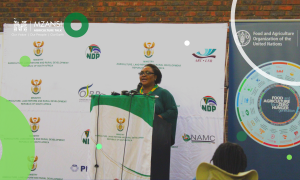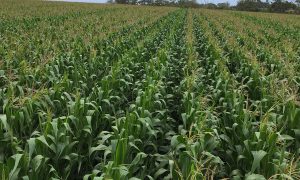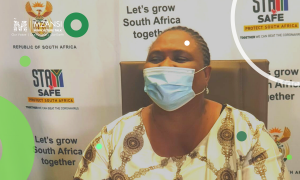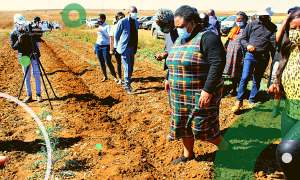The reported outbreak of the avian influenza has created material risk and uncertainty in the market. Avian influenza, also known as ‘bird flu’ is an infection usually of domestic and wild birds. Avian influenza is classified as the group of ‘influenza A viruses’ that are categorised as (i) low pathogenicity avian influenza (LPAI) A viruses, and (ii) highly pathogenic avian influenza (HPAI) A viruses. Both HPAI and LPAI viruses can spread rapidly through poultry flocks. Avian influenza is not a zoonotic disease. It cannot transmit to humans. There are nine known subtypes of A(H5) and A(H7) viruses with most identified in wild birds. HPAI is rarely reported in poultry as compared to LPAI. There are two proteins found on the virus (i) haemagglutinin (H) and, (ii) neuraminidase (N). These proteins are used to classify the subtype of the virus. The HPAI H5N1 and H7N6 virus strains have been reported as circulating in South Africa as of year 2023. The HPAI is a notifiable disease in the Republic. Farmers must notify the State Veterinarian when the disease is suspected. The farm is subsequently quarantined. Upon confirmation of HPAI disease, the farm is quarantined in addition to enhanced surveillance, biosecurity, movement control and traceability. Such activities are geared to prevent, reduce, and eliminate the infection and spread of the disease via personnel, vehicles, feed, chickens, eggs, and other materials.
On the economic front, eggs are the fourth largest animal production industry in South Africa in terms of the annual gross turnover after poultry meat, beef, and milk. Eggs are considered an affordable source of protein. Eggs are an integral ingredient in many dishes globally. It is advisable to cook eggs prior consumption. According to the Abstract Report by the Department of Agriculture, Land Reform and Rural Development (DALRRD, 2022) South Africa produces 562 000 tons of eggs per year. In contrast, consumption is recorded at just over 500 000 tons per year. Albeit per capita consumption is at 8.67kg per year. Hence, South Africa is a net exporter of eggs. In the year 2022, Mozambique was the main export destination followed by Eswatini. A couple of factors influence domestic demand of eggs. The main significant drivers are disposable income and population growth. Other factors such as changing lifestyles, improvement in production systems, and animal welfare are likely to influence demand. The anticipated disruption of the supply chain for eggs entail poor households are likely to switch to a more starch-rich diet due to unaffordability of eggs and declining disposable income.
In terms of poultry meat, South Africa consumes more poultry meat than it produces. The Abstract Report by the DALRRD (2022) depict consumption of poultry meat was recorded as 2.195 million tons juxtaposing production of 1.976 million tons. Imports closes the demand gap. Consistent with the theory of equilibrium in economics, the adverse impact of the HPAI would exacerbate supply-demand imbalance. The devastating impact of HPAI underscores the urgent need to turbo-charge implementation of the Master Plan. The Poultry Master Plan (PMP) articulates the following challenges that limits the latent potential of the industry (i) cost of feed that makes up over 70% of the cost of production. Maize and soya are key feed ingredients. Albeit priced internationally. Chicken is maize value-added (ii) Segmenting production in terms of balancing the carcass. White meat is sold at premium process whilst bone-in meat is exported to South Africa at lower prices. (iii) Inability to export to premium markets such as Europe due to sanitary and phytosanitary (SPS) requirements. (iv) Transformation in terms of ownership and control of the value chain. Transformation lies firmly at the heart of a normative and functional society. Agribusinesses and retailers exist and operate in social environment that does not encourage isolation of the entity from society. The financial requirement of the agribusiness should be intertwined with the social-economic imperatives of the society.
Assertions by Sir Winston Churchill to ‘never let crises go to waste’ is relevant to-date. First, the HPAI crises offer opportunities to overcome coordination defects. Initially intra government and further, inter social partners. Consistent with the aspirations of the Agriculture and Agroprocessing Master Plan (AAMP), social partners need to capitalise on the HPAI crises through working together for the common good of the sector. Efficiencies in the coordination and regulatory science innovation would improve evidence based decision-making and implementation capabilities. A strong working relationship by all social partners is necessary to ensure that fit for purpose biosecurity measures are in place and followed.
Second, crises can be a source of innovative ideas. The HPAI crises provides an opportunity for social partners to improve the capabilities of the animal health system through modernisation and continuous improvement. This includes bolstering the digital economy for the development of proactive and stronger prevention measures. Additionally, integrated surveillance for early detection and prompt interventions. Sensing technology and forecasting capabilities are necessary to be better prepared for uncertainty in the future. The Livestock Identification and Traceability System (LITS) and the Laboratory Information Management Systems (LIMS) are listed as critical intervention by the AAMP. Another innovative option is the localization of the production and processing of dried eggs. Third, consistent with the AAMP, the State should fast-track the process towards registration of vaccines as per Act 36 without compromising the safety, efficacy, and quality. The availability of effective vaccines provides a long term and sustainable mitigation to the ravaging impact of HPAI. Further, the Agricultural Research Council (ARC) via the Onderstepoort Veterinary Research should intensify research efforts to appreciate the modalities and prevention measures of the HPAI.
Fourth, the sector is facing existential and adverse impact of amongst others (i) high cost of production due to escalating fuel per barrel; (ii) crisis of intermittent electricity supply; (iii) high cost of burrowing; (iv) Inefficiencies in the rail, road, and ports infrastructure, (v) climate change and (vi) One-size-fits all farmer support packages that are unresponsive. All these factors require urgent, cogent, and coordinated response. Bespoke farmer support packages are critical to recovery. AAMP succinctly articulates interventions to drive recovery and inclusive growth.
Fifth, the International Trade and Administration Commission (ITAC) should expedite the investigation into the possibility of temporary rebate on import taxes and anti-dumping duties for importers. Albeit domestic consumption should be prioritized without causing long-term harm to the poultry industry. Sixth, the Competition Commission should continue as per legislative mandate to monitor essential food prices and prices throughout the value chain to determine whether consumers are being harmed by the state of competition. Similarly, the National Agricultural Marketing Council (NAMC) should keep a close eye on the Farm to Retail Spread. Free market economy is often accompanied by rent seeking behaviour. Consumers should be concerned about the potential for opportunistic pricing practices. The pursuit of singular financial motive is unsustainable. The public and affected parties suspecting unjustified pricing should lodge complaints with the Commission under sections 8(a): excessive pricing; 8(c): exclusionary conduct; and 9(1) (a) to (c): price discrimination in accordance with the Competition Act 89 of 1998, as amended. Seventh, the public should avoid panic buying. Similarly, retailers should limit the number of eggs being bought per customers. Adoption of egg rationing is likely to mitigate speculation by intermediaries.
Eighth, an aggressive awareness campaign should be initiated to take the public into confidence regarding the technicalities and implication of the HPAI. Last, the role of all social partners as powerful instruments to food security, livelihoods, development, and innovation should be the glue that holds value chain actors in the quest to mitigate the adverse impact of HPAI. Swift, cogent, coherent, and preventative measures are necessary to mitigate the impact of HPAI. The AAMP provides an anchor for coordinated and responsive interventions.




















